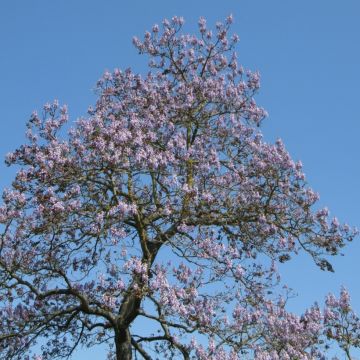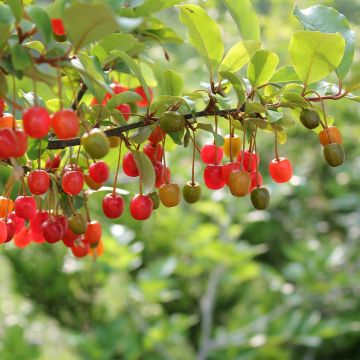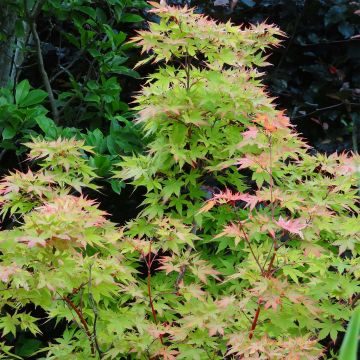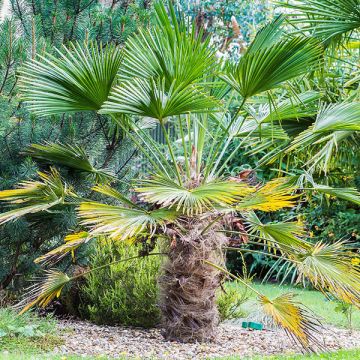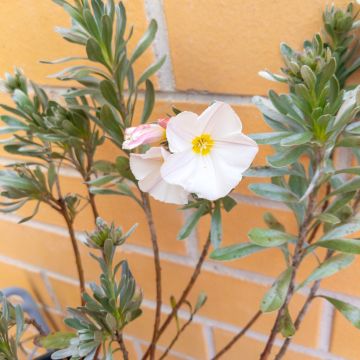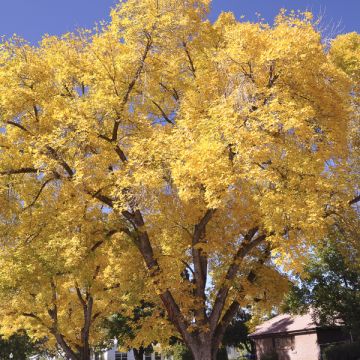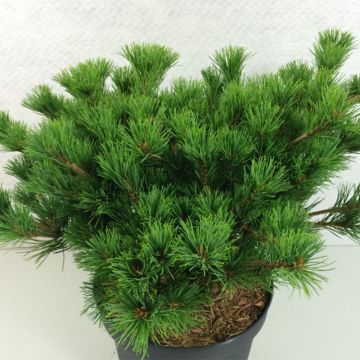

Paulownia elongata - Foxglove Tree


Paulownia elongata - Foxglove Tree


Paulownia elongata - Foxglove Tree
Paulownia elongata - Foxglove Tree
Paulownia elongata
Foxglove Tree, Princess Tree, Imperial Tree
After 7 months, the tree with leaves that are drying out, has not grown 1 centimeter in height!!! Wasted investment, big disappointment, and not worth buying at this price.
PÉAN W, 23/07/2024
Special offer!
Receive a €20 voucher for any order over €90 (excluding delivery costs, credit notes, and plastic-free options)!
1- Add your favorite plants to your cart.
2- Once you have reached €90, confirm your order (you can even choose the delivery date!).
3- As soon as your order is shipped, you will receive an email containing your voucher code, valid for 3 months (90 days).
Your voucher is unique and can only be used once, for any order with a minimum value of €20, excluding delivery costs.
Can be combined with other current offers, non-divisible and non-refundable.
Why not try an alternative variety in stock?
View all →This plant carries a 24 months recovery warranty
More information
We guarantee the quality of our plants for a full growing cycle, and will replace at our expense any plant that fails to recover under normal climatic and planting conditions.

Would this plant suit my garden?
Set up your Plantfit profile →
Description
The Paulownia elongata is a beautiful imperial tree species native to China. This tree shows extremely rapid growth and pubescent leaves reaching 75 cm (30in) in diameter. It offers a splendid spring flowering, with large upright panicles of purple, pleasantly fragrant. It often appears on bare branches, offering a grand spectacle. Melliferous and pioneering plant, this paulownia is not difficult to please. It provides pleasant shade and has a very exotic charm. Suitable for large gardens, this tree can be pruned to ground level every year for the beauty of its foliage, but it will not flower.
The Paulownia elongata is a large deciduous tree of the paulowniaceae or scrophulariaceae family, depending on the classification. It is a very robust species native to central China, where it is extensively cultivated for its lightweight wood, resistant to termites and carpenter ants. Highly resistant to cold, it is also a thermophilic species, most suitable for the Mediterranean climate and hot countries such as Italy, Spain, Croatia, North Africa, etc. The Paulownia elongata resembles the P. tomentosa, but its leaves are slightly longer and narrower, with a sharper tip. The flowers of P. elongata are also longer and darker. The mature tree can reach up to 28 m (92ft) in height in nature. In our climates, when not pruned, it will grow up to 12-13 m, with a spread of 6 to 8 m (20 to 26ft). It reaches its adult size in less than 10 years.
The Paulownia elongata forms a very long and straight trunk, topped by a rounded, airy, often slightly irregular crown. Its spreading branches become hollow with age. The branches that are 1 year old are reddish brown. The lush foliage is composed of very large heart-shaped leaves, light green in colour, measuring 40 to 75 cm (16 to 30in) in diameter. The lamina is smooth on the upper side; the underside has star-shaped hairs with a velvety touch. They turn yellow in autumn before falling. Flowering occurs in May, just before the leaves unfold. The flowers bloom at the end of the branches in upright panicles that can reach 35 cm (14in) in length. The flowers, trumpet-shaped, reach about 7 cm (3in) in length. Their colour varies from light to deep mauve, depending on the specimens. They have an orange-yellow throat and exude a delightful vanilla, powdery, and slightly almond scent. The tree blooms for the first time 6 to 8 years after sowing on branches that are 2 years old. The flowering is followed by the formation of solid, oval and pointed capsules that persist in winter, measuring up to 5 cm (2in) in length. The paulownia's root system develops a spider-like spreading root that penetrates the soil to a depth of 1 to 1.5 m (3 to 5ft), as well as a taproot that can go down to 8 to 9 m (26 to 29ft).
The Paulownia elongata is an extraordinary ornamental tree, and it finds its place in large gardens and parks, planted in rows or as a single tree. If you wish to contain its size and enjoy its foliage in an exotic atmosphere, you can also treat it as a coppice, cutting the tree back every year at the end of winter. In this case, it will sprout from the stump and form 4 m (13ft) tall shoots covered with immense leaves without producing flowers. This species is highly sought after in permaculture: it tolerates shade and feeds bees, and its foliage, which decomposes quickly, provides excellent compost. Its particularly dense root system promotes the establishment of numerous mycorrhizae while stabilising the soil.
Remarkable honey: paulownia honey is light yellow, transparent, light and aromatic, with a colour and texture similar to acacia honey.
Report an error about the product description
Plant habit
Flowering
Foliage
Botanical data
Paulownia
elongata
Bignoniaceae
Foxglove Tree, Princess Tree, Imperial Tree
China
Other Paulownia
View all →Planting and care
When planting a Paulownia elongata tree, choose an open area that allows unrestricted growth. It can thrive in full sun or partial shade and tolerate shade. Avoid windy locations as the large foliage is easily damaged, and the wood is brittle. It can grow in any type of soil as long as it is deep and well-drained. Too much clay or humidity can attract wood-rotting fungi, such as armillaria. After planting, water generously to remove air pockets. In drought, water for several weeks to encourage root growth. To enjoy the shade in summer, remove the lower branches when the tree is young. This makes it easier to move around underneath. To maintain the tree's health, remove diseased and dead wood. Thin out the centre of the tree by pruning overlapping branches. Avoid pruning large branches as it weakens the tree and makes it vulnerable to fungi. When coppice shoots pruning, cut the tree to ground level every year in late winter.
Planting period
Intended location
Care
-
, onOrder confirmed
Reply from on Promesse de fleurs
Similar products
Haven't found what you were looking for?
Hardiness is the lowest winter temperature a plant can endure without suffering serious damage or even dying. However, hardiness is affected by location (a sheltered area, such as a patio), protection (winter cover) and soil type (hardiness is improved by well-drained soil).

Photo Sharing Terms & Conditions
In order to encourage gardeners to interact and share their experiences, Promesse de fleurs offers various media enabling content to be uploaded onto its Site - in particular via the ‘Photo sharing’ module.
The User agrees to refrain from:
- Posting any content that is illegal, prejudicial, insulting, racist, inciteful to hatred, revisionist, contrary to public decency, that infringes on privacy or on the privacy rights of third parties, in particular the publicity rights of persons and goods, intellectual property rights, or the right to privacy.
- Submitting content on behalf of a third party;
- Impersonate the identity of a third party and/or publish any personal information about a third party;
In general, the User undertakes to refrain from any unethical behaviour.
All Content (in particular text, comments, files, images, photos, videos, creative works, etc.), which may be subject to property or intellectual property rights, image or other private rights, shall remain the property of the User, subject to the limited rights granted by the terms of the licence granted by Promesse de fleurs as stated below. Users are at liberty to publish or not to publish such Content on the Site, notably via the ‘Photo Sharing’ facility, and accept that this Content shall be made public and freely accessible, notably on the Internet.
Users further acknowledge, undertake to have ,and guarantee that they hold all necessary rights and permissions to publish such material on the Site, in particular with regard to the legislation in force pertaining to any privacy, property, intellectual property, image, or contractual rights, or rights of any other nature. By publishing such Content on the Site, Users acknowledge accepting full liability as publishers of the Content within the meaning of the law, and grant Promesse de fleurs, free of charge, an inclusive, worldwide licence for the said Content for the entire duration of its publication, including all reproduction, representation, up/downloading, displaying, performing, transmission, and storage rights.
Users also grant permission for their name to be linked to the Content and accept that this link may not always be made available.
By engaging in posting material, Users consent to their Content becoming automatically accessible on the Internet, in particular on other sites and/or blogs and/or web pages of the Promesse de fleurs site, including in particular social pages and the Promesse de fleurs catalogue.
Users may secure the removal of entrusted content free of charge by issuing a simple request via our contact form.
The flowering period indicated on our website applies to countries and regions located in USDA zone 8 (France, the United Kingdom, Ireland, the Netherlands, etc.)
It will vary according to where you live:
- In zones 9 to 10 (Italy, Spain, Greece, etc.), flowering will occur about 2 to 4 weeks earlier.
- In zones 6 to 7 (Germany, Poland, Slovenia, and lower mountainous regions), flowering will be delayed by 2 to 3 weeks.
- In zone 5 (Central Europe, Scandinavia), blooming will be delayed by 3 to 5 weeks.
In temperate climates, pruning of spring-flowering shrubs (forsythia, spireas, etc.) should be done just after flowering.
Pruning of summer-flowering shrubs (Indian Lilac, Perovskia, etc.) can be done in winter or spring.
In cold regions as well as with frost-sensitive plants, avoid pruning too early when severe frosts may still occur.
The planting period indicated on our website applies to countries and regions located in USDA zone 8 (France, United Kingdom, Ireland, Netherlands).
It will vary according to where you live:
- In Mediterranean zones (Marseille, Madrid, Milan, etc.), autumn and winter are the best planting periods.
- In continental zones (Strasbourg, Munich, Vienna, etc.), delay planting by 2 to 3 weeks in spring and bring it forward by 2 to 4 weeks in autumn.
- In mountainous regions (the Alps, Pyrenees, Carpathians, etc.), it is best to plant in late spring (May-June) or late summer (August-September).
The harvesting period indicated on our website applies to countries and regions in USDA zone 8 (France, England, Ireland, the Netherlands).
In colder areas (Scandinavia, Poland, Austria...) fruit and vegetable harvests are likely to be delayed by 3-4 weeks.
In warmer areas (Italy, Spain, Greece, etc.), harvesting will probably take place earlier, depending on weather conditions.
The sowing periods indicated on our website apply to countries and regions within USDA Zone 8 (France, UK, Ireland, Netherlands).
In colder areas (Scandinavia, Poland, Austria...), delay any outdoor sowing by 3-4 weeks, or sow under glass.
In warmer climes (Italy, Spain, Greece, etc.), bring outdoor sowing forward by a few weeks.
































